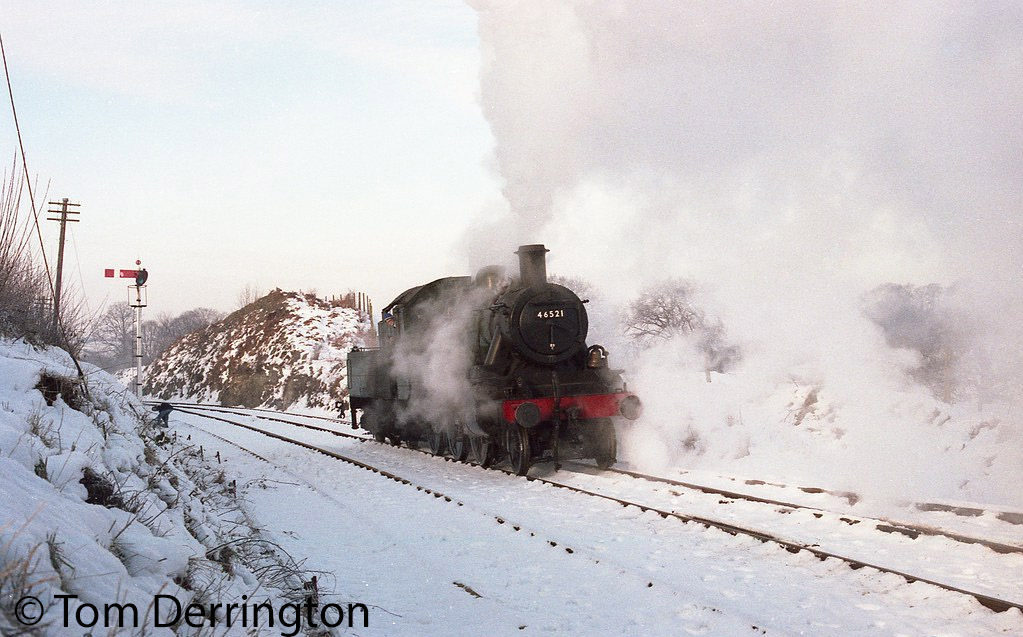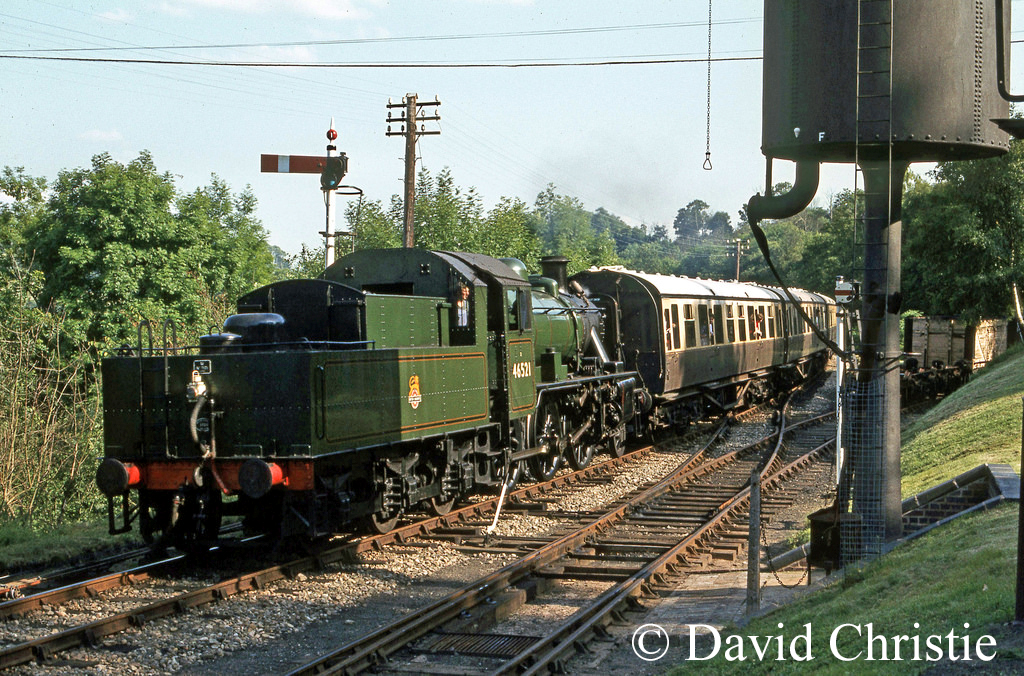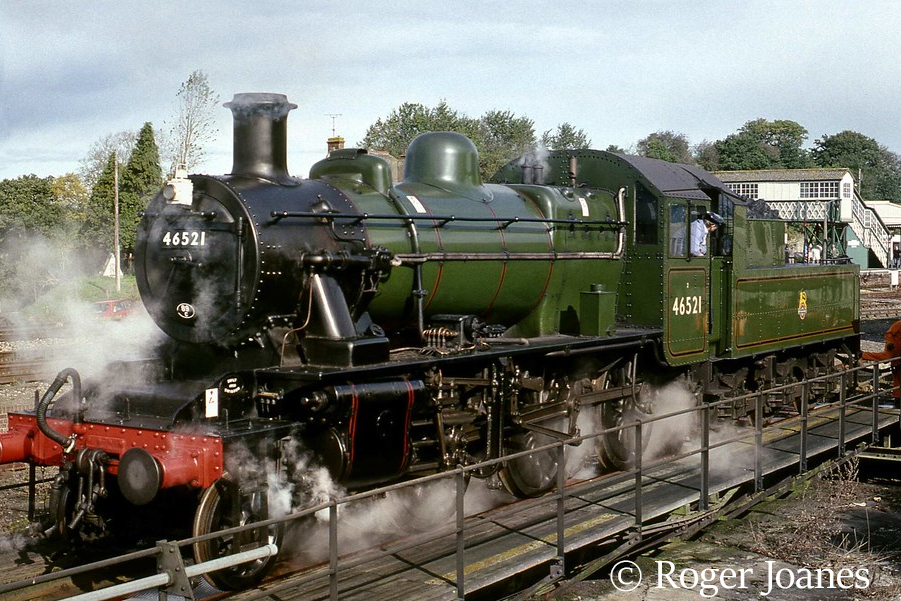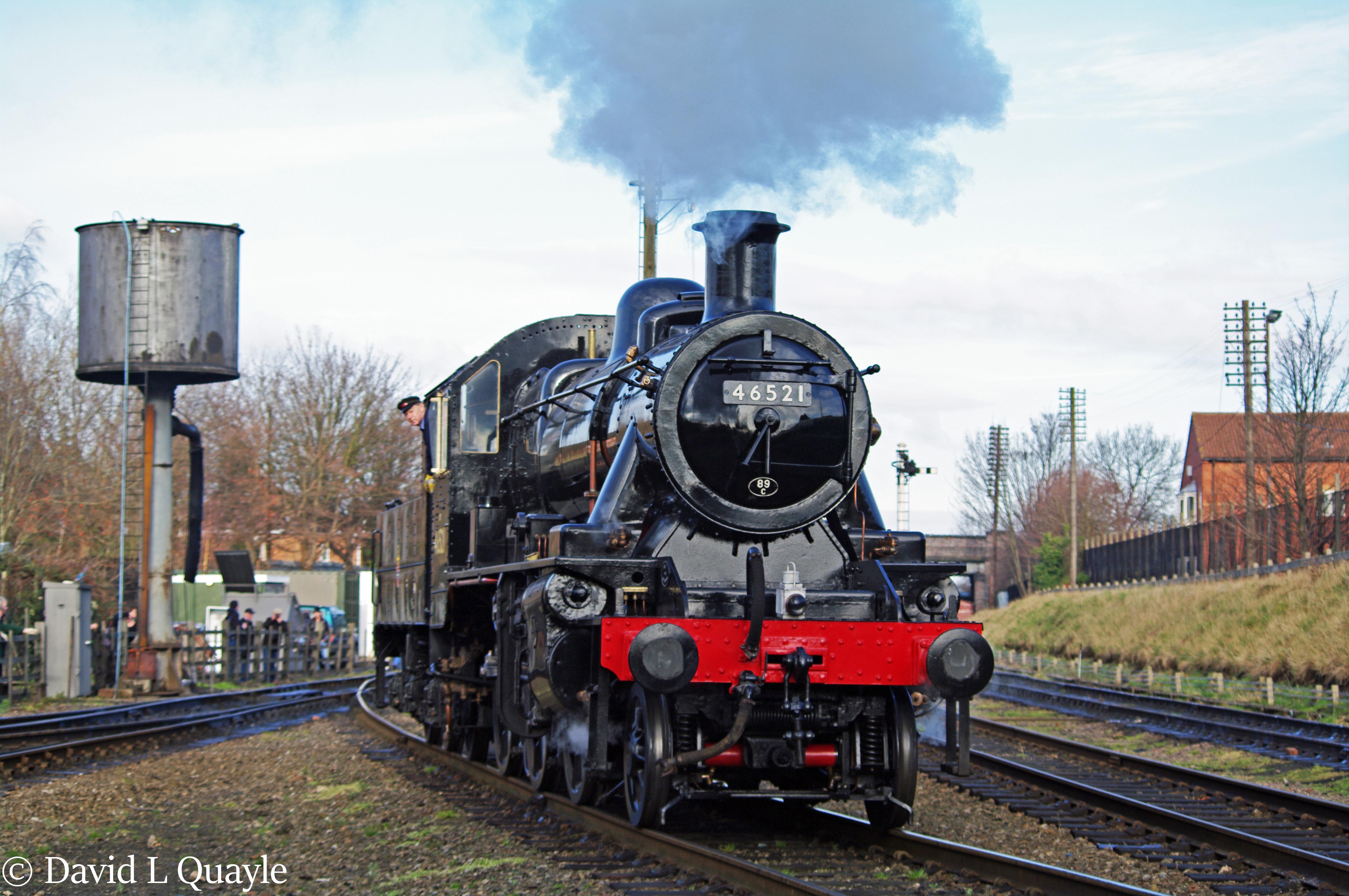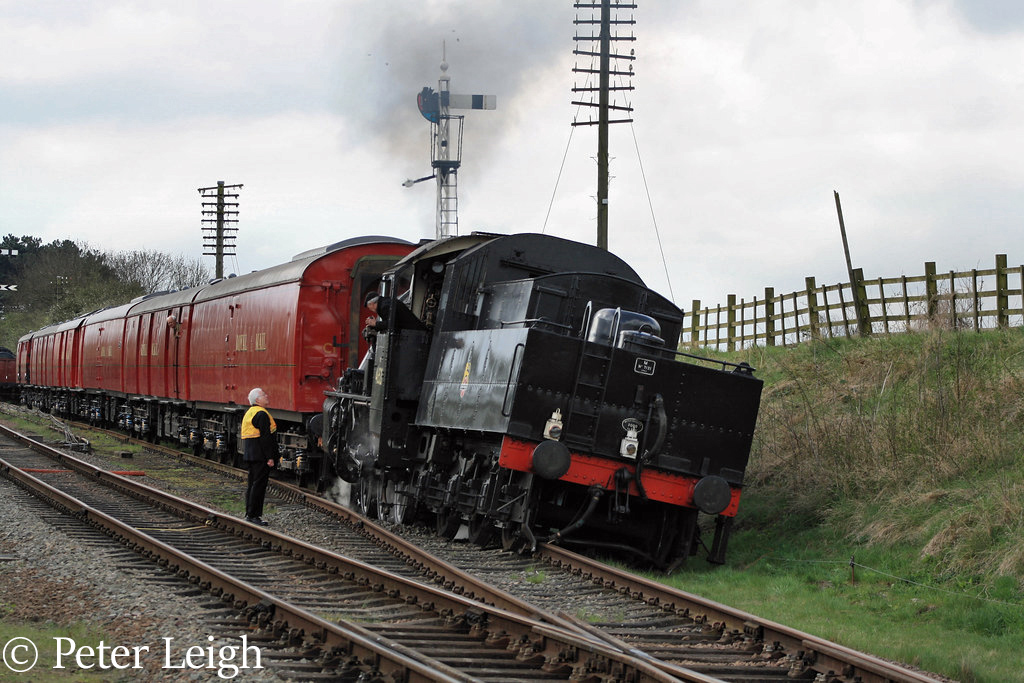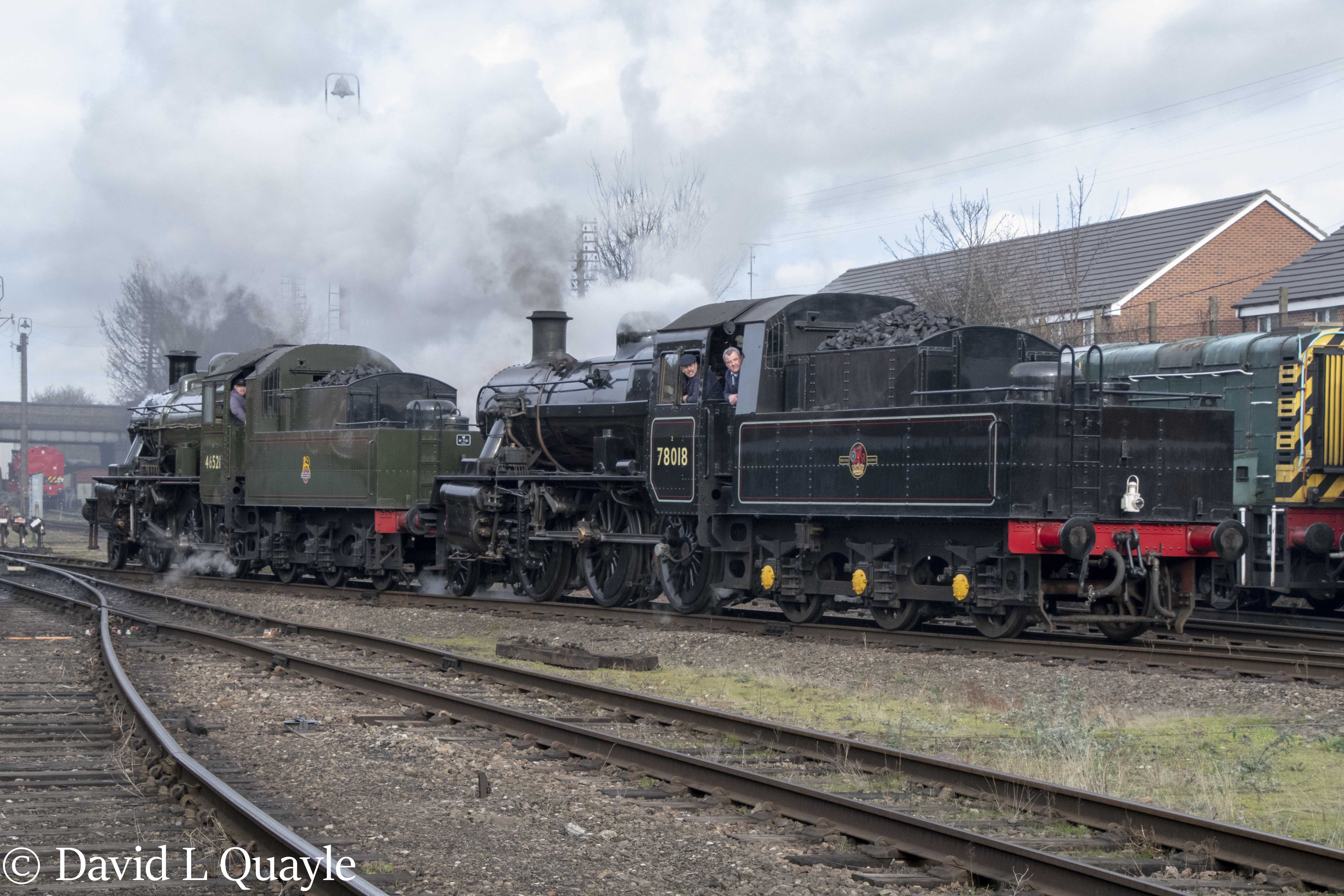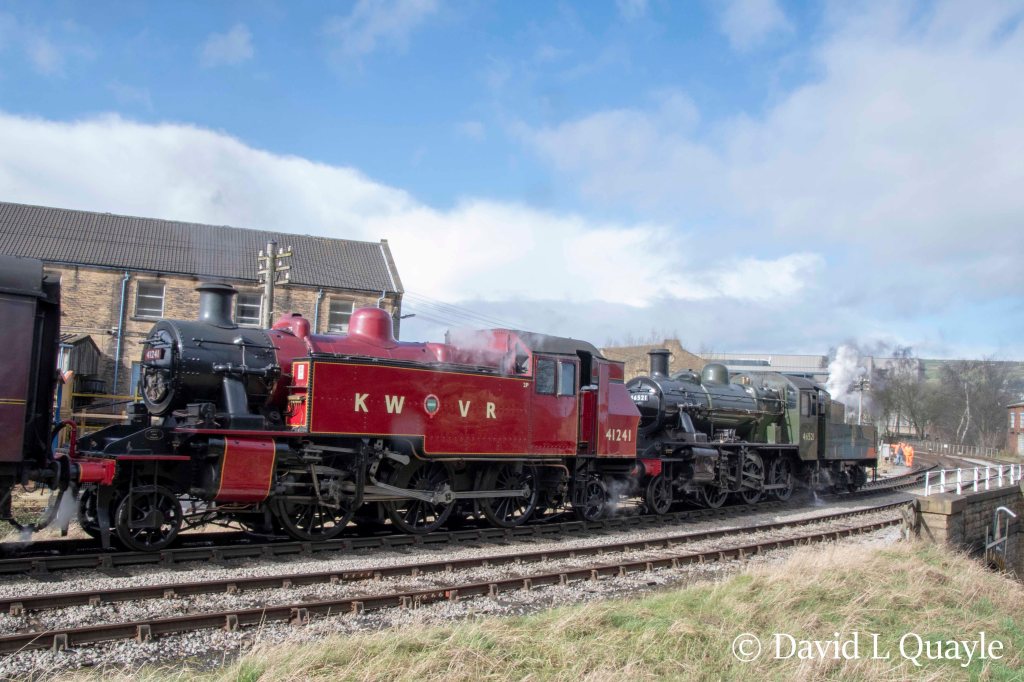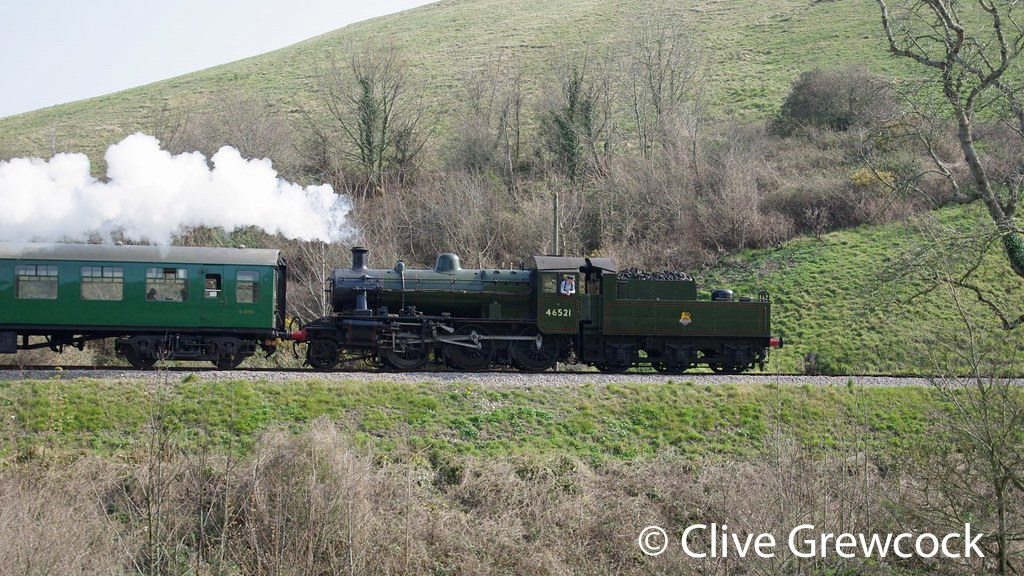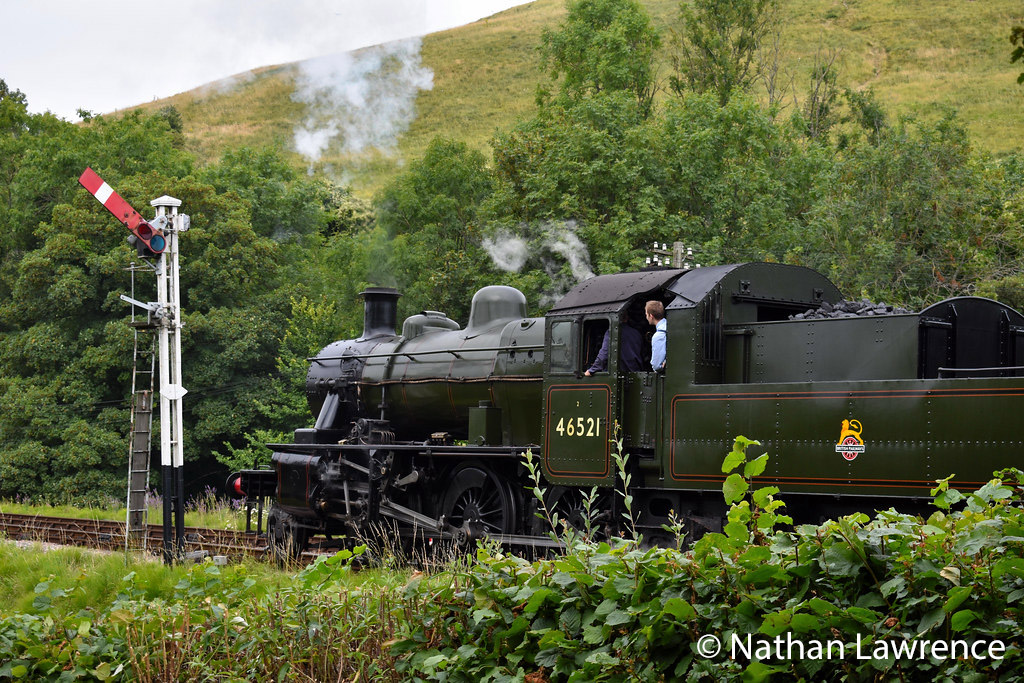
46521 was completed at Swindon in February 1953 at a cost of £13,756 as part of the last batch of locomotives of the class built.
BR motive power depot allocations.
| Date Arrived | Depot |
| February 1953 | Oswestry |
| March 1953 | Brecon |
| October 1959 | Oswestry |
| March 1963 | Machynlleth |
46521 was transferred from the Western Region to the London Midland Region in September 1963 when Machynlleth depot was transferred to London Midland Region Control.
Prior to this the locomotive was sent to Crewe works where it underwent a heavy overhaul during May and June 1963. The overhaul was probably undertaken because the engine was earmarked for Royal Train duties which it undertook when the queen visited North Wales in August 1963.
It was withdrawn from service at Machynlleth in October 1966 and sold to Woodham Brothers at Barry for scrap. It arrived at Barry in March 1967 and was resident there until March 1971.
In 1969 46521 was selected for preservation by Severn Valley Railway (SVR) member Charles Newton. The locomotive arrived at the SVR on 20 March 1971 and entered service in July 1974, becoming the SVR’s first ex-Barry restoration to be completed. The locomotive initially carried the same green livery in which it finished BR service, although in 1975 both 46421 and 46443 (which was also at the SVR) were painted into red livery and given modified superstructures for filming of The Seven-Per-Cent Solution. 46521 was eventually withdrawn from service in 1977 for major boiler repairs.
Following completion of the overhaul, a second period of service commenced, this time ending in 1985.
A third period of service began in 1991, during which 46521 spent the summer of 1993 on hire to the Gloucestershire Warwickshire Steam Railway, as well as taking part in the London Underground ‘Steam on the Met’ festival the same year. 46521 also featured as ‘Blossom’ in the BBC sitcom Oh, Doctor Beeching! which was filmed between 1995 and 1997. 46521 was formally named ‘Blossom’ by actor Steven Lewis in a ceremony in February 1997. 46521’s third period of service ended in 2000 by which time the locomotive had accumulated 84,031 miles since it was preserved.
After negotiations between David Slack, representing Loughborough Standard Locomotives Group Ltd (LSLG) and Charles Newton, the locomotive was moved to the Great Central Railway (GCR) for overhaul by LSLG in November, 2001 and is now owned in equal shares by LSLG and Charles Newton.
The overhaul on the Great Central Railway
The overhaul did not really start in earnest until LSLG had completed the restoration from scrapyard condition of standard class 2MT 78019, but the locomotive was allocated space in the locomotive shed and stripping down began. It soon became clear that the locomotive chassis and tender would need a lot of work, but the major concern was the condition of the boiler.
Chassis
The overhaul of the locomotive chassis was mostly straightforward. Once stripped down and cleaned, rectification started. All the locomotive wheel sets were re-profiled and the springs refurbished. The job of overhauling the horn guides and axle boxes and re-assembling the chassis back onto its wheels was given to David Wright of Locomotive Maintenance Services. The coupling and connecting rods had new brasses manufactured and the motion new pins and bushes where necessary. The crossheads were re-metalled and machined and the cylinders and valves checked and re-ringed. The long valve rods on which the actual valve heads themselves are mounted had to be re-machined true, as did the piston rods themselves, before new glands were fitted. The lubrication system was cleaned out and checked and the brake gear re-bushed. The only initial headache was that the steam brake cylinder was damaged, but Cast Iron Welding Services in Coalville did a first class repair, so the problem was overcome. Everything was painted and attention turned to the tender.
Tender
The tender was stripped and the wheel sets sent for re-profiling, axle boxes overhauled and the springs refurbished. The dragbox was found to be very badly corroded and after much new steel and a lot of welding, was made good. The compensated brake gear also benefited from new pins and bushes and the pipework for the train vacuum pipe renewed where it passed through the dragbox, where it had rusted all the way through. Attention then turned to the tank, which was also very badly corroded and wasted through in places. In the end, the front half of the entire floor, most of the coal space and the bunker sides were all renewed. The injector water valves were overhauled and trackside water fillers were also fitted for convenience in service, as was a coal space spray.
Boiler
The boiler that was on the locomotive was the original and had many years of hard work behind it, so it was clear that the work required on it was going to be extensive and costly. Once the boiler was lifted from the frames, a thorough examination was conducted to work out the best way forward. Several solutions were considered, including sending the whole boiler to Meiningen in Germany for overhaul at the same works that built new boiler for the class A1 Pacific Tornado, but contractual and type approval complexities ruled this avenue out. Eventually, L&NWR Co Ltd at Crewe Heritage Centre were selected for the boiler overhaul. In the meantime, LSLG members had stripped down the boiler as much as was considered necessary, removing the tubes, flues, foundation ring, firebox tube plate, roof stays and many side stays, before despatching the boiler to Crewe. At this point, as unfortunately is very normal with these things, further examination revealed rather more work required.
A brand new firebox copper tube plate was manufactured as the old one was completely worn out, but Crewe also had to remove the firebox copper doorplate to repair cracks and corrosion around the fire hole door on the inside of the steel backhead. The bottom half of the copper doorplate was replaced with new material and the firebox also had new copper half sides fitted. This was mainly due to very deep caulking grooves that during a previous life had been hammered into the plates whilst attempting to seal the firebox stays from leaking. The steel backhead below the fire hole, almost the entire steel throatplate and both outer firebox steel sides were renewed and the shoulder patches re-riveted back on. The foundation ring was repaired and replaced and all of the mud hole doors repaired, as well as a full set of new washout plugs fitted. All boiler fitting mounting pads were machined true and new cascade plates fitted in the boiler below the top feed (these items disperse water delivered from the injectors around the boiler as evenly as possible).
It was then time to replace the firebox stays where all of the new plates had been fitted. The roof stays were steel, but a great debate ensued about the material to be used for the firebox itself. The locomotive was originally fitted with monel metal (a form of nickel steel) stays, as the material never seems to wear or but monel is a very expensive material and steel is a substitute frequently used for this application. However, steel does wear and corrode and the view was that the job should only be done once and noting that all of the material around the stays had been renewed it was decided to have model metal stays fitted. The material cost of doing this was £18,000.
The fitting of the small tubes and the flues was straightforward and the boiler was then successfully hydraulically tested with water, before passing its steam test in early September, 2011. The boiler was then quickly despatched back the Loughborough.
Reassembly
As soon as the boiler returned effort was directed towards reassembling the locomotive. Whilst the boiler had been away, LSLG had prepared as many things as possible to ensure that everything was ready for its return – for example, a brand new hopper ashpan had been manufactured and all the insulation cladding was ready to be fitted. All the boiler fittings had been overhauled and preparations for fitting a steam chest pressure gauge made.
Everything went relatively smoothly and the locomotive moved under its own power for the first time in almost 11 years to the day just before Christmas, 2011. A few snags were ironed out over the next couple of weeks before the Pakes Painting Co painted 46521.
Summary
When the overhaul of 46521 was started, it was estimated that it would cost approximately £100,000, but it ended up being over £170,000 on the boiler alone. Steam locomotives are not cheap, especially as they get older.
The locomotive returned to service again in late 2011.
The boiler certificate was due to expire in January 2022 but an extension to October 2022 was agreed after which the locomotive was taken out of service..
In October 2023 it was reported that the locomotive had been transported to Tyseley for its axleboxes and boiler to be overhauled. It will return to the Great Central Railway following this work for the rest of the overhaul to be undertaken.
| Home Base | Current Status | Owner |
| Great Central Railway | Under overhaul | Charles Newton/Loughborough Standard Locomotive Group Ltd |






